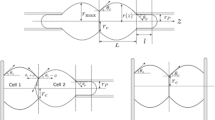Abstract:
In many experimental situations, the adhesion of cells to solid substrates is due to non-covalent chemical bonds. It is the thesis of this paper that many phenomena occurring in cell detachment experiments, such as in I (E. Decavé, G. Garriver, Y. Brechet, B. Fourcade, F. Bruckert, Biophys. J. 82, 2383 (2002)), result from the static and dynamic properties of the adhesive bridges at the extreme margin of the cell. This region defines the adhesive belt where the distribution of connected bonds crosses over to zero where the membrane leaves the substrate. The theoretical model we introduce in this paper discusses the threshold force together with the peeling velocity in the same theoretical framework. In this one-dimensional model, the threshold force results from a non-homogeneous distribution of anchor proteins along the membrane so that the adhesive belt increases its capacity to resist motion with increasing the external force. Analyzing the kinetics of the the contact line motion, we derive the characteristic relationship speed versus external force and we describe the non-equilibrium state of the adhesive belt as a function of the speed. We discuss our model in view of the experimental results obtained with D. discoideum for hydrodynamic shear experiments. Our results could be also confronted to single-cell observations.
Similar content being viewed by others
Author information
Authors and Affiliations
Additional information
Received 14 January 2002
Rights and permissions
About this article
Cite this article
Garrivier, D., Décavé, E., Bréchet, Y. et al. Peeling model for cell detachment. Eur. Phys. J. E 8, 79–97 (2002). https://doi.org/10.1140/epje/i2002-10010-8
Issue Date:
DOI: https://doi.org/10.1140/epje/i2002-10010-8




